#a parallel to young literati
Explore tagged Tumblr posts
Text
what i would do if i was a gilmore girls writer:
april storyline:
i feel like instead of the april storyline liz could have given birth a bit earlier and and luke and lorelai would have to step in to help raise doula a lot. first of all we’d get to see them with a baby, which is cute. but there’s also a lot of room for conflict in deciding how to handle the situation. aka conflict that makes for good TV (”should we even have kids together if we can’t even do this?”, ”we have to make these decisions together, we’re getting married!” etc.) but isn’t life altering enough to ruin the couple. it also draws parallells to the jess storyline (which was a huge part of the earlier seasons), luke’s established family issues and his earlier disagreements with lorelai which makes luke’s character arc and the show as a whole more cohesive and satisfying. i could see this drama lasting for all of season 6. in the end because these characters have grown, they would actually figure it out somehow. and then they’d have season 7 to settle down and be happy. i actually do love april but they could have made her a young sheldon type of guest character at yale and paris could have developed a soft spot for her or something.
literati in season 3:
so i feel like they wanted to show us that this is rory’s bad boy phase. they made their relationship about dean a lot and most of the episodes centered around them were like ooooh jess did this sucky thing and dean never would have. and i get that maybe they needed to try something new and didn’t want to just recreate the boyfriend storyline with a new guy (aka see how he fits into her grandparents world, saying i love you for the first time etc). they already did the good stuff with dean so they decided to make this rory’s bad decision and only came up conflict to show us. but they didn’t even fully commit bc rory didn’t change with jess the way she did with logan. that was her bad boy phase, literati was always supposed to be something more. so instead of showing how bad of a couple this was compared to dean/rory, they could have drawn different parallels. because dean/rory was not a perfect relationship and they could have shown how in some ways why this is better for rory. what does she want? not her grandparents and not her mom. after all the buildup literati was the audience’s favorite and most anticipated couple, so i really think painting it as an unexpected but positive change of direction in rory’s journey would have been worthwhile.
like show us how when they go on dates they want to do the same things (as opposed to donna reed or rory just watching dean’s games). show us how they both want their alone time and them not calling each other every day because rory wants to study and jess has to work can be an OK thing (as opposed to the infamous 14 calls a day). show us how jess maybe doesn’t fit into lorelai and rory’s flow as well as dean did BUT how that’s also ok because rory is getting older and going off to college so this makes sense. but then also show us some god damn character development and lorelai and jess actually learning to get along (pls make that an entire episode’s storyline actually. have them be funny together and make it emotional). and show us nice scenes with luke, lorelai, rory and jess. where was all of this when they were dating??? nowhere to be seen. although i would have liked for luke not to kick jess out (i will make another post of how i would handle jess and luke’s relationship in season 3) i know it had to happen because milo had to leave. and i wouldn’t change major plot points like that because i like jess’ arc too much. but if they had shown everything i wrote here, literati’s realtionship would have canonically been stronger and jess would have at least told rory about not graduating and his dad showing up and why he felt like he had to go before he went.
dean cheating on lindsay with rory:
actually i would have had lindsay push him in the lake luke pushed jess in but oops plot twist, dean can’t swim
44 notes
·
View notes
Text
A Teeny Sneak-Peak of “SUMMER- On a Slow Boat Trip Going Nowhere”
And just because I want to, here's a sneak peek of the upcoming sequel to Jess and Denny's Travel Series:
I hit “SEND” and smile for the first time after seeing Rory today at the restaurant. It was quite surprisingly fast how close Denny and I had gotten close over Spring Break, given that one day, out of the blue she called me, asking me to tag along for my New Orleans/Memphis leg of my book tour and by the end of the week, we were already scheduling calls over the next few months.
I continued touring for my book, but even I could realize that it didn’t feel the same way. It is then that Denny and I devised a plan to split-screen movies together- we’d watch from our respective locations the same movie and talk about it on the phone. Kind of like in ‘When Harry Met Sally’, when they’re watching ‘Casablanca’ together from their own homes and talking about the ending that many people continue to be stuck on- “should Ilsa have gotten on that plane? Or chose Rick?”. So far, we had finished watching about 17 different movies from different genres and were now stuck on the last half of Douglas Sirk’s ‘Written on the Wind'.
Thinking about that movie gives me the hives, cause for some reason, I could feel myself reflected in Rock Hudson’s character, powerless and unable to tell the woman he loves that he’s in love with her and when he does... she chooses her husband over him. Of course, fate plays a hand and... he gets the girl in the end. But I learnt the hard way that life doesn’t work out like that.
But now, after reading Denny’s email, I found myself with the comforting fact that it was okay not to have romantic stability, it was okay that I was still figuring things out at 37, and that I had better things to worry about. Like my sister. It had been nice, knowing and learning on that week-long road trip that I didn’t just have Luke in my corner, and that Denny was someone who was like a friend, a best friend if I’m being honest. I wish I’d known it sooner.
As I crash in Chris and Maya’s guest bedroom (I had to start looking for places in New York now if I wanted to move ASAP), I hear a beep from my phone, and see a text from Denny- You awake?
I type back- Yep.
I’m so glad to know that you’re going to make it this weekend- so are Luke and Lorelai. I take it that life’s been busy, huh?
I type back- Just because I’ve been busy, doesn’t mean I’ve forgotten you. I open the Instagram video meme that Lily sent me a while back as a gag, and I forward it to Denny with a simple- Here’s proof.
[Video attached]
After a minute, Denny types back: ROFL 😂😂😂. And I chuckle and immediately stop myself, in order to not wake my hosts up. I look down and see Denny with another text- You’re sure you and Lorelai aren’t going to engage in barbarian wars, right? I don’t want to start having to call one of you Attila.
I chuckle and type back- I’ve managed handling myself around Lorelai. Don’t worry. And then- I’ll see you soon, okay? Now go to sleep. It’s late!
She types back- Just had to fine-comb through potential damage control. And besides, I won’t be able to sleep for the next few hours for reasons that I won’t disclose on text.
5 seconds later, comes the last text- I’ll see you soon. Goodnight. 😘😘😘
And I type back- Goodnight ☺️. And put away my phone.
Sleep comes easier after that. And for the first time, I look forward to this coming weekend in Stars Hollow.
#jess mariano#doula danes#jess and doula#road trip au#sequel to au#summer cruisin'#summer romance#sneak peek#jess x rory#rory gilmore#a parallel to young literati#slow burn#think Midge and Lenny at the end of 'Its Comedy or Cabbage'
1 note
·
View note
Text
I was reading the book It Ends With Us, and Lily and Atlas give me Literati feels! If you haven't read this book yet go read it, especially if you love Rory and Jess! I mean Atlas and Lily are so similar to Jess and Rory, they have their differences but they have their similarities too! Atlas like Jess didn't know his dad his mom was a flake and neglectful like Liz and her husband was abusive to him, and he ended up getting kicked out, and eventually ended up homeless and alone as a teenager, he came so far and like Jess he doesn't feel like he's good enough for Lily, and he spends years trying to be good enough for her, and he waits forever for her they are literally right person wrong time like Rory and Jess and ugh I just love their story too! Lily grew up different from Rory in she only had her mother, Lily had both her parents but her dad was extremely abusive, and they ended up bonding through their trauma, similar to Rory and Jess they had their own little form of escape. Atlas like Jess worked his way up from having nothing and made something of himself! They both went from rock bottom to being content in their lives, still waiting for their love to be ready for them! Atlas and Lily also have a helping each other factor to them like Rory and Jess do! Lily cared for Atlas when nobody else did like Rory cared for Jess when nobody (besides Luke) did. Lily "saved" Atlas when they were young and in return Atlas "saved" Lily when they were older, the same way Rory "saved" Jess when they were younger and Jess "saved" Rory when they were older. Lily and Rory both have a baby with another man, while Jess and Atlas both would take in their babies as their own and love them as their own child. Literally so many parallels between them and ugh they are my new favorite book couple I just love Lily and Atlas so much, they hold a special place in my heart like Jess and Rory do! 🥺🥰💞
#jess and rory#literati#gilmore girls#jess mariano#rory gilmore#jess x rory#rory and jess#rory x jess#it ends with us#colleen hoover#lily and atlas
48 notes
·
View notes
Text
Yoon Seungho and Yeonsangun
A hot scary tyrant with anger issues and rampages of violence, a sex addict, a traumatized boy tormented by the shadow of his father… Who am I referring to? King Yeonsangun or our Yoon Seungho? Because both stories match really well.
So on this post I’ll share why I believe Seungho is inspired in Yeonsangun, the 10th king of the Joseon dynasty and the cruelest ever known.
Here I will leave a link with a nice and underrated video I found that summarizes the info on Yeonsangun: https://www.youtube.com/watch?v=IEUJPNfMMQo&t=295s and will leave some movie recommendations as well.
I will start by summing up the canon facts of Yeonsangun and Yoon Seungho that are very similar, then proceed to do assumptions and theories n.n
TW: This will contain mentions of death, sex, rape and psychological abuse so be careful
>Yeonsangun felt like he lived under the shadow of his father the king Seongjong, he was often criticized by the ministers and compared to him and even aimed some hate towards him as he allowed the death of his mother lady Yoon, same happens with Seungho that says to “be living by the principles of his father” in a very sarcastic way and sends lusty paintings to bother him and having nightmares when father Yoon comes to his mind. Both being the eldest son to inherit all the responsibilities.

>King Yeonsangun was a sex adict, he made a whole brigade of ministers to recruit 10.000 virgins for him who would live in the Sungkyunkwan (basically the Joseon Confucianism university of the capital Hanyang later known as Seul ofc) to serve him making this a brothel. Our dear Yoon Seungho attended and hosted orgies on a daily basis right? Pretty similar. Both known for their crazy libido and not caring about public spaces huh.

>This king was known for his episodes of anger since he was a child and when he became the king (19) killed his tutor the Seungho version of this would be how cold blooded he killed a servant on chapter one.

>Yeonsangun might have been a tyrant but he was also a hottie, described to be a bit feminine having a nice built and a color skin pale as pricey jade just like our protagonist. Here a ss of Yeonsangun being portrayed on the treacherous (2015) pretty hot right?
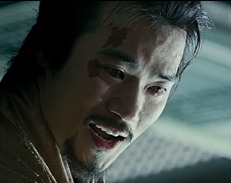

>Sadly, before getting to know how his mother was killed Yeonsangun was known to be a nice man, a good king caring and organized, brilliant in poetry and smart but turned out the monster the history books describe know because of his traumatic past. This mirrors our potn quote “He was actually one of the brightest young men in this region…” oh my lord Yoon they did you so wrong
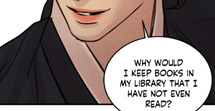
>This king is known for the bloodiest purges on Korean history killing a lot of the Sarim faction (basically the scholar side of the politicians and nobility) and Seungho’s family is related to a purge… hmm… This was caused when he found out why and how his mother (Deposed queen Yoon, yeah the surnames are important to be told!) was cruelly killed with poison which ended up in the literati purges.
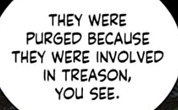
Those are the canon facts so far! I’ll continue with assumptions now stay with me <3
+This has to be the most fun one and is heavily based on the annals of Joseon and a very well-known film “The king and the clown” (2005) So Yeonsangun had a royal consort that was Jang Nok-su who was his favorite and treated him as a baby
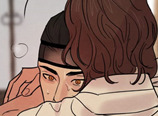

and another known favorite one was his royal juggler whose real name I don’t known but is portrayed as Gong-gil in the movie so the consort was very jealous of the clown who was a lowborn ofc Nok-su is known for being poisonous and villain like while Gong-gil was allegedly a pure and cute soul very feminine like (Are we all getting the Jihwa and Nakyum vibes?) Lemme point out some scenes on the movie that are tremendously similar to our favorite manhwa: So the consort grew jealous of the clown as he got more and more favored by the king, he was the chosen to spend the nights playing puppets to the king and the first thing she noticed was how Yeonsangun looked at Gong-gil, there was even a scene where the consort gets in top on him trying to get him stripped
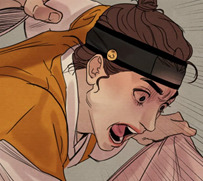
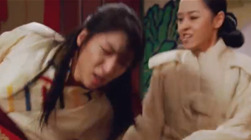
bc he had received a gift from the king (to Royal robe was on his shoulders)
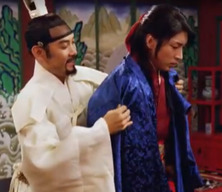
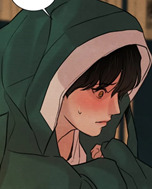
And guess what the king made? Drag her outside (not by the topknot but extremely similar way) as she yells HOW DARE YOU!! While her little thingy from the hair falls. the level of parallelism, astronomical.

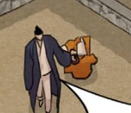
He even has a very worried prime minister who plays his cards in secret to please the king, very Kim like. He even looks like this panel as he was killing someone.
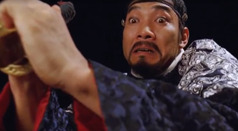

We also get a “Because the way you looked at him is not the way you look at me” shot as Gong gil looks at his partner tenderly
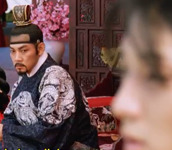

Some extra ones: Yeonsangun had Gong-gil on the palace against his will and allegedly kept him as entertainment but ended up kissing him lol. And Gong-gil used to be a prostitute before (just like Nakyum thought of himslef:c)
+Basically in both of the films I’ve mentioned so far he is portrayed as mentally ill, insomnia, hallucinations, dissociation, etc. And as a child (being treated as one by his consort and having childish behavior, etc.). Which are things I assume SH has too (well he is canonically ill with insomnia though)
+In the treacherous (2015) Yeonsangun likes to paint erotic paintings (which idk if was real but he was smart and skilled in arts such as poetry as I've read so this a nice headcannon about Yeonsangun that could have inspired Byeonduck nim). Plus, the sex scenes are so vivid and explicit... Like Potn
Well thanks for bearing with me now here I go with the last info and some theories (?)
-So what caused this king to be so unstable and such a tyrant was when he found out about the cruel destiny of mother Yoon) Could Seungho’s past be related to something like this? His mother being mistreated and having an indecent death? Or his lover perhaps? Anyways a purge is also mentioned in the manhwa so if you connect some points please tell me!
-His father, Seogjong was praised sure but also banned a member of the Lee clan (The royal clan, yes Lee was their surname just like Jihwa’s also written as Yi) for living and having a daughter with his slave, this makes me remember Mummyeong and Jihwa’s relationship (The girl was Yi Guji) and strengthened the rules towards widoweds not remarrying. Might me just my extra Sagittarius imaginations loving taking everything to the extreme but this somehow resembles how father Yoon fucked up Seungho and Jihwa calling them “ill”
-Finally their names sound really similar, just me? Yeonsangun Yoon Seungho and I mean look at the pic on the video cover and this korean interview on Lezhin... They are twins!

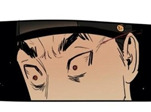
The main reason I do this is to have open discussion, go ahead roast and debunk my theory or praise it!! Reactions, feedback and opinions are welcome. If you want the theory in Spanish text me or text me whenever you want let's discuss let's chat. I am mostly active on twitter @Seunghosgirl
#painter of the night#potn#seungho x nakyum#seungho#baek nakyum#nakyum#jihwa#mumyeong#nameless x jihwa#yeonsangun#the king and the clown#painter of the night nakyum#yoonseungho#yoon seungho
46 notes
·
View notes
Photo
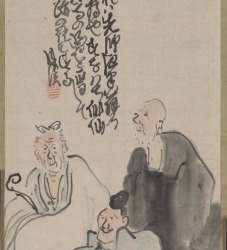
A Poetic Gathering, Matsumura Goshun, late 1700s-early 1800s, Cleveland Museum of Art: Japanese Art
In Japan, both Chinese-style poems (kanshi) and Edo period Japanese poems (haikai) paralleled the Chinese literati and Japanese painting haiga traditions. Edo literati painter Matsumura Goshun painted eight poets from the anthology of 36 haikai poets compiled by his teacher Yosa Buson. When Buson died in 1783, Matsumura was asked to care for his teacher’s young daughter; Matsumura added paintings to Buson’s poetic writings to sell and raise money for her marriage. Here, he included Buson’s poem at the top of the painting. Size: Image: 106.4 x 26.8 cm (41 7/8 x 10 9/16 in.); Overall: 184.2 x 34 cm (72 1/2 x 13 3/8 in.) Medium: hanging scroll; ink and color on paper
https://clevelandart.org/art/1983.188
10 notes
·
View notes
Photo
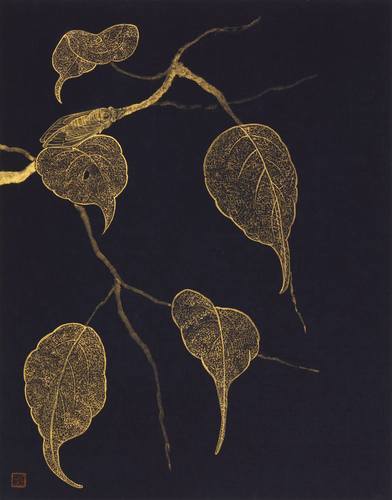
Prayer of A Cicada, HyunJung Kim
Drawing: goldpowder and realgold on Paper. Heaviness wrapped up with Lightness – Reading Kim HyunJung’s painting Lee DongChun (Fine art Connoisseur) Kim HyunJung’s paintings are cute and interesting. Her painting reminds us of paintings by Qi Baishi 齐白石 (1864-1957). Qi Baishi pursued beauty in his life, and his artistic spirit is found in his plant-and-insect paintings, flower-and-bird paintings, and figure paintings. Qi Baishi’s artistic spirit is sensed in Kim’s interesting subject matter and candid depiction.Kim audaciously uses ink and bright hues in in the manner of Qi Baishi who applied ink to leaves and red to flowers 墨叶红花. The composition in which subject matter is drawn to the edge of the paper is parallel to that of Qi Baishi’s flower-and-bird paintings and landscape painting of Li Keran’s 李可染 (1907-1989). Kim obviously learned from Qi Baishi. Qi Baishi said, “Learn from me you stand, copy from me you fall 学我者生, 似我者死.” Kim modeled herself after Qi’s artistic spirit rather than his painting style. Kim explored the artistic spirit in Qi Baishi’s painting, in which he emphasizes the meaning of painting and expresses his spirit, and reconstructed this in a realistic rendition. She calls this the “chulsa-ipgong 出写入工” technique. This is a melding of “xieyi 写意” painting (painting that underlines the painter’s spirit), “gongbi-hwa 工笔画” (painting done very carefully with the utmost care for details), and a new invention in tune with her emotion. Zheng Xie 郑燮 (1693-1765), one of the Eight Eccentrics of Yangzhou during the Qing Dynasty asserted, “Learn half, and throw away half 学一半, 撇一半.” This means even if a tradition is excellent, you have to learn only half of it. However, the traditional is currently completely disregarded. Kim learned her ‘half’ from traditional Eastern techniques. She studied the idioms of flower-and-bird painting from Song Dynasty, and learned from artists such as Chen HongShou 陈洪绶 (1599-1652), Yun ShouPing 恽寿平 (1633-1690), ShiTao 石涛 (1641-1707), BaDaShanRen 八大山人 (1625-1705), Gao QiPei 高其佩 (1660-1734), Jin Nong 金农 (1687-1764), and Kim HongDo 金弘道 (1745-1806). Moreover, she explored new methods in expression of color in traditional techniques. As she felt insufficiency in the use of pigment to depict significant parts of a painting, she made use of embroidery. This technique called “hwaju-subo 画主绣补” (Paining is used as primary and embroidery as ancillary) brought a new vitality to gongbi-hwa. The techniques of “chulsa-ipgong” and “hwaju-subo” are not the only revolution and innovation Kim has pursued. Getting psychological counselling, Kim realized the existence of her inner-child. She named her “Lala” and represented her special emotion in a pictorial language through this. Her Lala painting is a projection of her inner-child that she became aware of through psychological consultation, and for the artist a process of healing. This painting is in no way the product of pop art, but the sublimation of an artist’s inner-child to a work of art for the first time in art history. Kim’s Finding implicit rules is a portrayal of a young girl in meditation. The little girl carrying Lala on her back gazes vacantly at a dragonfly on a bare branch against the backdrop of a brick wall. Lala and the little girl look cute. The brick wall is a metaphor for constant time whereas the bare branches and dragonfly represent finite time in nature. The dragonfly acts out as the last leaf by O. Henry (William Sydney Porter, 1862-1910). As a projection of a psychological essay in painting, this work is a new literati painting of the 21st century reflecting Kim’s distinctive art-world. Kim lends new energy to gongbi-hwa through her realization of traditional Eastern painting. Kim has incarnated the spiritual world of intellectuals in our age in exquisite, flamboyant gongbi-hwa. This is why Chinese aestheticians and art historians have recently taken note of Kim’s painting.
https://www.saatchiart.com/art/Painting-Prayer-of-A-Cicada/960197/3943611/view
4 notes
·
View notes
Note
Love your folkloregirls posts and gif sets! Which songs do you think match the couples (mainly Luke/Lorelai and literati) on the show the best?
Thank you so much I appreciate you! :)
To me, August is early Literati (specifically the bridge!), Exile is s6 dinner fight Literati + looking back on past miscommunication/mistakes, The 1 is s6 post-kiss Literati (”I persist and resist the temptation to ask you if one thing had been different, would everything be different today” vs “It’s what it is. You, me.” and “In my defense I have none for digging up the grave another time” vs Rory feeling guilt about trying to use Jess), and Cardigan (especially the bridge) is general post-breakup and Revival Literati when they’re able to reflect back on the relationship with some new insight/fondness!
This is Me Trying is VERY much a Jess-centric song that particularly fits that period of time between (and including) him finding out he’s not graduating and him showing up at Yale.
I go through more specific lyrical parallels here and here
As for Luke x Lorelai I consulted my local expert @lorelaigilmo and she says Invisible String (as she beautifully demonstrated here!!) as well as Exile for the whole later-seasons Chris vs Luke drama (”Like you’d get your knuckles bloody for me” Come on, goes without saying).
She also made a really interesting argument about how Cardigan could reflect the immaturity of Lorelai and Chris’s relationship (her growing up without him, her having to go through with actually marrying him to clear up her “what-ifs,” her believing she “knew everything when [she] was young” becoming independent as a teen, etc.)
If you’re interested in more Luke x Lorelai anaylsis I would definitely recommend shooting her an ask, she loves that stuff :)
Also if you’re interested in more Taylor Swift x Literati parallels from outside folklore, I did an obnoxiously in-depth breakdown here!
#ask#asks#my answers have been so long lately I'm sorry guys lol but the asks have been so good#useless rambles with tay
9 notes
·
View notes
Text
--- (Literati)
Dedicated to @rumaan (for the amazeballs lit stuff she’s been writing) and @aurimaedre because she gets my feelings about stuff.
..
It’s four weeks this time, instead of four months. She shows up at Truncheon again, and he’d be flattered if he hadn’t seen the gossip articles.
Of course it’d be about Huntzberger again. They’re on the outs again (something about his fiancee giving him an ultimatum - involving Rory, of course) and of course Rory’s first instinct is to come to him. He’ll always pick up her pieces.
Because he’s Luke.
The parallels haven’t escaped him. Apparently all girls do date their fathers, because Huntzberger is so damn much like Rory’s absentee dad... And judging by the curve of Rory’s belly, she is more like her mother than even she expected.
She takes his silence to mean acceptance, and she throws herself into the chair across his desk.
“Hey,” she says, obviously trying to sound more upbeat than she feels.
“Hey,” he responds.
What else is there to say?
“Hey,” she repeats.
“Hey,” he continues the pattern. “At least some things haven’t changed.”
Some things never change, and his gigantic soft spot for Rory Gilmore is just one of those things. He may have told Luke that he was over that, but he has always been a great liar - and even better at self-delusion.
“It’s not just a food baby,” she comments on his pointed look at her belly.
“I figured,” he tries to remain calm. “Even the Gilmores have limits, crazy as they may be.”
He’s witnessed the eating habits of both mother and daughter over the years, and he knows how Luke despairs. He can see the appeal of trying to keep them healthier, but he’s also smarter than Luke. It’s never going to happen. Though there was this month when Lorelai ate several apples and things were really tense for some reason.
“How’s the coffee withdrawal going?” he breaks the silence.
“Don’t mention the C-word,” Rory huffs.
Of course he laughs. She just looks so... childish, so damn young. She is thirty-two and she hasn’t changed that much in the last fifteen years. Her eyes light up the same - and he’s still a goner for that smile.
That is, if she ever bestows it upon him again.
He’s too much like his uncle, because he returns to a years-old mission: make her happy.
50 notes
·
View notes
Link
LAST AUTUMN, New York Film Festival kicked off an international retrospective of works by the prolific experimental filmmaker Barbara Hammer. For 50 years, Hammer has devoted herself to unapologetically exhuming, assembling, and celebrating the lesbian image as no one has before. Her films, produced in 1974, 1997, and 2015, stage lesbians as unabashed hippie separatists, a Jewish sculptor thriving during the Occupation (Claude Cahun), and a Pulitzer Prize–winning poet (Elizabeth Bishop). More than a hundred moving pictures later, many newly restored, there’s never been a better time to know Barbara Hammer — as much as one can, anyway. As Hammer herself mused during the Q-and-A which concluded NYFF’s Barbara Hammer Program: “Do we ever know anyone? I don’t think we do. I think we die alone and we are born alone and I do my damndest to show who I am by making films.”
Instead of focusing on Hammer’s own movies, IFC Center, in partnership with Queer | Art | Film, enriched the retrospective by screening seven early feminist experimental films, selected by Hammer, that motivated her to grab life by the Bolex. In them, we see her fevered adoration of sex, community, and innovative cinema. Dyketactics’s twirling intimacy and idealism echo Carolee Schneemann’s Fuses (1965); History Lessons’s feminist snicker, Martha Rosler’s Semiotics of the Kitchen (1975); and Place Mattes’s erotic fixation on the hands, Yvonne Rainer’s Hand Movie (1966). Who influenced Barbara Hammer’s work? It is IFC Center’s thorough answer to this question that compels me to ask another one: who is influenced by Barbara Hammer’s work? I recently spoke to several members of the new guard on working in the wake of Hammer. Her presence, while purely administrative for some and literal for others, was always palpable.
¤
The 1980s produced a large bounty of Hammer films and Hammer scions: young filmmakers — sometimes lesbian, sometimes queer, but always feminist-identified. Now in their 20s and 30s, they are eager to grapple with the idea of a creative disconnect between generations. “The most important lesson I take from Hammer is her self-awareness that she is inventing a lesbian voice, lesbian view, lesbian cinema,” Daviel Shy, who premiered her first feature, an adaptation of Djuna Barnes’s biting 1928 chapbook The Ladies Almanack, at The Roxie Cinema in San Francisco on June 30, tells me. “Formally, I may be far more ‘tame.’ But I operate from a commitment to lesbian cinema, history, and culture as a real and living calling.”
Sex is an all-consuming part of Hammer’s early films, from Dyketactics (1974) to the naturalistic Multiple Orgasm (1976) to the acrobatic arts showcase Double Strength (1978). These are the images created, unbelievably, by a woman who was once groomed by her parents to become the next Shirley Temple. Instead, Hammer imagined worlds that are still being reimagined by the avant-garde’s progeny. In Dyketactics, women, having taken “back to the land,” roam barefooted through water and leaves. Their active, idyllic lives are emphasized by the 16 mm film’s diligent crossfades of flowers, candles, and fruit into nude women — all embodying a Nelson-eque sameness, their homemade coiffures and fair skin a tad too homologous.
Liz Rosenfeld’s Untitled (Dyketactics Revisited) (2005), shot in 16 mm like its Hammer predecessor, assimilates the bodies and environments that have been left on an era’s cutting room floor. “The visual skin and mix of the technologies is crucial to the work,” says Rosenfeld. Untitled isn’t so much a glowing tribute to Dyketactics as it is something entirely new, meant to — as Liz tells me — serve as “reinterpretation of queer contemporary moment and proposition queer future while also referencing its past.” Its frolicking bodies are varied, some clothed, some wearing that which is in-between nudity and cloth: the chest binder. Untitled’s playground is a cold industrial city, Chicago, understood by Rosenfeld to be just as much of a queer colony as Hammer’s. When asked about Untitled in an interview with Polari Magazine, Hammer celebrated the throwback to her old work, declaring, “Long live Dyketactics and may there be more iterations!”
In Shy’s The Ladies Almanack, Natalie Barney engages in a tryst with Oscar Wilde’s drug-addled niece Dolly, revealing a series of moon phases tattooed down the actor’s spine. The ink pairs rather nicely with the Almanack’s subtitle: “showing their Signs and their tides; their Moons and their Changes; the Seasons as it is with them; their Eclipses and Equinoxes.” Colette, like Rosenfeld’s Hannah Höch, has a facial piercing. While historically white, Shy’s casting also aids Barney’s salon in getting with the times: Mimi Franchetti is portrayed by a person of color; so are Thelma, Lily de Gramont, and a number of other late 19th-century creatives who, while renowned and often celebrated for their work and sexual deviancy at the time, rarely grace today’s textbooks. Almanack also cleverly recruits established members of today’s feminist literati to portray the women who paved the way for their work: Eileen Myles takes on Monique Wittig; Terry Castle, Gertrude Stein.
¤
Joey Carducci, an instructor at Pratt Institute, first met Hammer while working as a contact printer operator in Hell’s Kitchen. When Hammer, impressed by Carducci’s lab skills, realized he was an idling 16 mm filmmaker, she insisted they collaborate. Bolexes in tow, the two roamed through Coney Island’s Astroland on the 46-year-old amusement park’s final day in 2008. Carducci films Hammer as Hammer films Carducci; the resulting project would become known as Generations. A bittersweetness hovers over Generations’s 14 minutes and 36 seconds, as though something new is being born from that which one has yet to properly mourn. Hammer the wiser and Carducci the younger brim with newfound creative energy as Astroland illuminates Brooklyn’s dusk one final time.
This phoenix motif is part and parcel of the Carducci-Hammer collaboration. In 2015, Hammer led A Place Called Hope, a public workshop where she generously offered digitized copies of her film outtakes to participants so they could create a work that was both vintage and contemporary, individual and collaborative. Carducci selected scraps from Tender Fictions (1995), Hammer’s follow-up documentary to Nitrate Kisses (1992). Tender is the closest Hammer has come to crafting a traditional memoir film. “I was born at a time when Shirley Temple was making more money than any other female in the United States. I was taught early to perform and perform I did,” Hammer begins in voice-over, lulling the viewer into a false sense of genre security before shifting into an alter ego. “In Tangiers, I robbed an American Express with my Swiss Army Knife,” she continues, thwarting the viewer’s quest for an earnest documentary.
Tender Fictions was the perfect foundation for Carducci, who by then identified as a transman, to come out to his cherished mentor. In A Letter to Barbara Hammer (2016), Carducci uses her outtakes to ask permission to use them in a broader project about his transition, tentatively titled Coming Outtakes. “As queers, if our identities are expansive and self-defined, am I still a ‘Bolex dyke,’ as we had nicknamed ourselves after making our film? Am I still the lesbian experimental filmmaker you didn’t want the world to lose? Or am I a Bolex dude, another white man in the film industry?” he painfully wonders as clips from Tender Fictions roll. Fearless, Carducci’s respect for Hammer and love for experimental cinema eclipse the weight of his coming out. “I was born at a time when Barbara Hammer was making more 16 millimeter experimental films than any other lesbian in the United States,” he says, riffing on Tender Fictions’s opening line.
If queer cinema traditions possess a shared characteristic, it is this preoccupation with our community’s own expansive chronologies and chosen genealogies. Film allows one to go the distance: to compensate for archival limitations, address forbidden intimacies in the frankest of terms, and approach historical repression with a sense of humor.
Hammer’s third decade is defined by her trilogy of 16 mm historical documentaries: Nitrate Kisses, Tender Fictions, and History Lessons (2000). Borrowing its name from the highly flammable film base, Nitrate Kisses, disputed by funders and faith leaders, ponders the same erasure of queer life to which it was narrowly subjected. Hammer’s early trademark eroticism persists, but with a newfound sophistication: as the gay couple make love, the Hays Code scrolls across the picture. Like its namesake, Nitrate Kisses refuses to be extinguished, even when soaking wet.
The same year that Barbara Hammer and Joey Carducci premiered Generations, Liz Rosenfeld released the first in her own trilogy of semi-historical experimental short films, two being shot on 16 mm. Frida & Anita centers on a chance encounter between the artist Frida Kahlo and Weimar performer Anita Berber in Berlin in 1924. Rosenfeld followed Frida & Anita with speculative biographies about Dadaist Hannah Höch (HÖCH), Leni Riefenstahl, and Eva Braun (Die Neue Frau) in 2014.
This time, Rosenfeld, who is based in Berlin, didn’t realize the parallels between her Surface Tension Trilogy and Hammer’s earlier series. Nor did she realize that they shared a subject in Höch (whose history Barbara explores in her 1998 film The Female Closet). “It’s a funny coincidence,” Rosenfeld says. At the same time, this mutual interest in forgotten figures and their stories seems natural, even imperative. “I think that as queer people we do gravitate toward understanding our own histories, especially because they are so untold, lived through the body, rather than written down, and also based on stories passed down, interpretations of films, books, images that have been left behind, and of course, gossip,” mused Rosenfeld.
Shy, who spent three years researching fin de siècle literary communities before adapting Barnes’s text, echoes her sentiments. “Our history was not codified and canonized, thank goodness, so our history is whatever transpired experientially between women.” It is fitting that Hammer also once desired to adapt Barnes’s modernist fiction (the author’s literary executors rebuffed her efforts to secure the rights to the 1936 novel Nightwood).
The “tension” in Rosenfeld’s Surface Tension Trilogy refers to the relationship between the past and present. It engages in its own variations of Hammer-esque smudging and collage. Apart from period clothing, there is little effort to obscure spatial or physical anachronisms. The three films borrow from the few archival materials available as much as they do a present-day understanding of queer connection and community. “For me, history is at the crux of all my work,” Rosenfeld tells me. “I am thinking about past or future histories, and especially in relationship to how history is carried through the body, which is where my work really lies at the intersection of both film and performance.”
Frida & Anita is shot in the style of a 1920s silent movie, with a letter the author sent to her father while in Berlin occupying the intertitles. The anachronism bleeds through her entire series, beginning with our introduction to the strip-teasing Anita Berber (Richard Hancock), who is presented as an illustrious transwoman. The line between Cabaret and RuPaul’s Drag Race becomes increasingly slim.
An ambitious undertaking, Shy’s The Ladies Almanack, filmed with Super 8 and spanning 86 minutes, also uses the anachronism to link the past to the present. A cast of over 25 is essential to depict the revolving door of writers, artists, friends, and lovers who moved through Natalie Clifford Barney’s salon at 20 Rue Jacob, Paris. While the performers boast the mannerisms, language, and vintage filter of Radclyffe Hall, Djuna Barnes, and Romaine Brooks, the salon’s constituency simultaneously resembles a group of patrons at Henrietta Hudson’s on any given Friday night. This is deliberate. “Any period piece says more about the time it was made than the time it portrays,” says Shy. “My film does not try to fight that fact. The process was always about finding corollaries between them and us, then and now. The anachronisms are to bring them closer, not to give history the middle finger. There is a philosophical and emotional faithfulness to the book that I was trying to adhere to, and to do that honestly we would have to enter the picture.” Like its source text and the almanack form it appropriates, the film occurs over a calendar year, broken up into monthly chapters.
“Recently, I decided to call myself a ‘hystorian,’” Shy tells me. “For us, or any person whose past has been abridged, erased, or doctored, one has to modify the popular story of what happened in order to burrow closer to the truth.” Rosenfeld’s and Shy’s imaginative approach to articulating the past has clear roots in Hammer’s own work. “History Lessons is one of my favorites,” she explains. “I think playing with history is important, and to engage deeply with any material one cannot be overly reverent,” she acknowledges.
¤
Brooklyn-based filmmaker Sasha Wortzel’s work focuses on an undocumented regional history that isn’t as debaucherous as Weimar Berlin or bygone as bohemian Paris. Her first feature documentary, We Came to Sweat: The Legend of Starlite, which premiered at Film Society of Lincoln Center in 2014, details the rich past of her neighborhood’s oldest Black gay bar, recent attempts to shutter the hub, and the community members who, valuing the Starlite’s past as much as its future, resisted its closure. Wortzel has also tampered with form to connect a current audience with its past. In 2011, having accumulated footage of an elderly lesbian in the wake of her partner’s death, she jerry-rigged these vignettes into a typewriter. When a key is pressed, a clip plays through a screen situated near the obsolete device’s paper table. Titled 42 Butter Lane, the installation features interviews about the quotidian (wallpapering disagreements, anecdotes of homophobia) and shots of the survivor’s half-empty home.
Wortzel’s Butter Lane parallels Hammer’s short No No Nooky T.V. (1987). An Amiga computer emits Valentine-like drawings-in-progress and feminist declarations that symbolize the ebb and flow of Hammer’s short-lived summer romance. Crafted at the height of the debate on film versus video, Hammer decided that she wanted both and filmed her computer. Like Butter Lane, Nooky combines incompatible forms of technology to capture the weight of a lesbian relationship that’s reached its end. In both works, death of format and death of lover collide, albeit in inverse. Wortzel insists that the digital appreciate its elder: the analog.
¤
When asked, “What do you wish for?” in an 2001 interview with Filmmaker Magazine, Barbara Hammer responded, “I hope that before I die I can start a Barbara Hammer Fund for queer filmmakers who use experimental form in their work and do not replicate the status quo.” Sixteen years later, that wish came true. Yet Q|A|M’s Lesbian Experimental Filmmaking Grant should not be viewed as the Hammer’s first act of creative altruism. Rather, it commemorates the work she has been doing for young filmmakers, unsung, for a number of years.
Daviel Shy first met Hammer at her book launch. “We chatted and she signed my book with the words, ‘Daviel Shy, what a name — as good as Hammer. Go for it — in film and art, Barbara Hammer,’” she recalls. “Hammer came back into my life once more as a staunch supporter of The Ladies Almanack. At our fundraiser at the Leslie-Lohman Museum, she did an impromptu plea for donations and read her favorite passage from Nightwood.” Hammer, who turned 79 this year, has shared films with Joey Carducci, collaborated with Sasha Wortzel, and screened her work alongside Liz Rosenfeld’s.
When asked what she was thinking after the screening of her films at New York Film Festival last year, Hammer responded, “I thought of all the films we are not looking at tonight. All the exploration of what history is, how we’ve been left out of history, this empty hole that is now being filled by courageous, queer, wonderful, diverse, expansive lesbian, gay, and trans community.” Today’s queer experimental film community is the one she has been waiting on since she became the first. “The construction of sexuality and sexual expression seem to me to be fluid and changing. This is most important and interesting, for it leaves open the doors of possibilities for future constructions of sexual histories,” she wrote eight years ago in her memoir.
Doors that, thanks to Hammer, new filmmakers are passing through in strong numbers.
¤
Sarah Fonseca is a publicly educated film writer and essayist from the Georgia foothills who lives in New York City. Her work has appeared in Black Warrior Review, cléo: a journal of film and feminism, IndieWire, and the Lambda Literary Review, among others.
¤
Feature image by Alice O’Malley.
The post From Hystorians to Bolex Dudes: The Many Descendants of Barbara Hammer appeared first on Los Angeles Review of Books.
from Los Angeles Review of Books https://ift.tt/2uKNRV5
0 notes
Photo
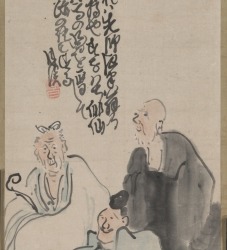
A Poetic Gathering, Matsumura Goshun, late 1700s-early 1800s, Cleveland Museum of Art: Japanese Art
In Japan, both Chinese-style poems (kanshi) and Edo period Japanese poems (haikai) paralleled the Chinese literati and Japanese painting haiga traditions. Edo literati painter Matsumura Goshun painted eight poets from the anthology of 36 haikai poets compiled by his teacher Yosa Buson. When Buson died in 1783, Matsumura was asked to care for his teacher’s young daughter; Matsumura added paintings to Buson’s poetic writings to sell and raise money for her marriage. Here, he included Buson’s poem at the top of the painting. Size: Image: 106.4 x 26.8 cm (41 7/8 x 10 9/16 in.); Overall: 184.2 x 34 cm (72 1/2 x 13 3/8 in.) Medium: hanging scroll; ink and color on paper
https://clevelandart.org/art/1983.188
6 notes
·
View notes
Photo
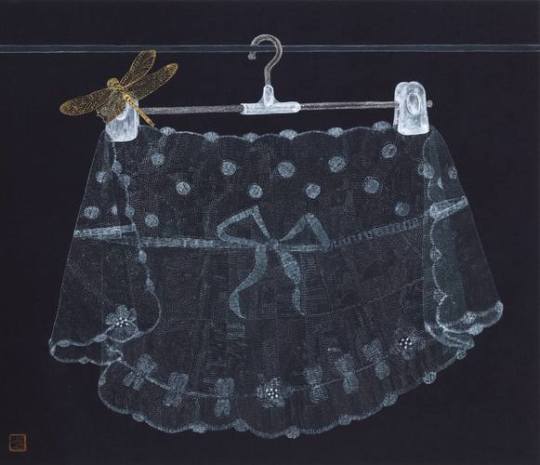
Veil, HyunJung Kim
Heaviness wrapped up with Lightness – Reading Kim HyunJung’s painting Lee DongChun (Fine art Connoisseur) Kim HyunJung’s paintings are cute and interesting. Her painting reminds us of paintings by Qi Baishi 齐白石 (1864-1957). Qi Baishi pursued beauty in his life, and his artistic spirit is found in his plant-and-insect paintings, flower-and-bird paintings, and figure paintings. Qi Baishi’s artistic spirit is sensed in Kim’s interesting subject matter and candid depiction.Kim audaciously uses ink and bright hues in in the manner of Qi Baishi who applied ink to leaves and red to flowers 墨叶红花. The composition in which subject matter is drawn to the edge of the paper is parallel to that of Qi Baishi’s flower-and-bird paintings and landscape painting of Li Keran’s 李可染 (1907-1989). Kim obviously learned from Qi Baishi. Qi Baishi said, “Learn from me you stand, copy from me you fall 学我者生, 似我者死.” Kim modeled herself after Qi’s artistic spirit rather than his painting style. Kim explored the artistic spirit in Qi Baishi’s painting, in which he emphasizes the meaning of painting and expresses his spirit, and reconstructed this in a realistic rendition. She calls this the “chulsa-ipgong 出写入工” technique. This is a melding of “xieyi 写意” painting (painting that underlines the painter’s spirit), “gongbi-hwa 工笔画” (painting done very carefully with the utmost care for details), and a new invention in tune with her emotion. Zheng Xie 郑燮 (1693-1765), one of the Eight Eccentrics of Yangzhou during the Qing Dynasty asserted, “Learn half, and throw away half 学一半, 撇一半.” This means even if a tradition is excellent, you have to learn only half of it. However, the traditional is currently completely disregarded. Kim learned her ‘half’ from traditional Eastern techniques. She studied the idioms of flower-and-bird painting from Song Dynasty, and learned from artists such as Chen HongShou 陈洪绶 (1599-1652), Yun ShouPing 恽寿平 (1633-1690), ShiTao 石涛 (1641-1707), BaDaShanRen 八大山人 (1625-1705), Gao QiPei 高其佩 (1660-1734), Jin Nong 金农 (1687-1764), and Kim HongDo 金弘道 (1745-1806). Moreover, she explored new methods in expression of color in traditional techniques. As she felt insufficiency in the use of pigment to depict significant parts of a painting, she made use of embroidery. This technique called “hwaju-subo 画主绣补” (Paining is used as primary and embroidery as ancillary) brought a new vitality to gongbi-hwa. The techniques of “chulsa-ipgong” and “hwaju-subo” are not the only revolution and innovation Kim has pursued. Getting psychological counselling, Kim realized the existence of her inner-child. She named her “Lala” and represented her special emotion in a pictorial language through this. Her Lala painting is a projection of her inner-child that she became aware of through psychological consultation, and for the artist a process of healing. This painting is in no way the product of pop art, but the sublimation of an artist’s inner-child to a work of art for the first time in art history. Kim’s Finding implicit rules is a portrayal of a young girl in meditation. The little girl carrying Lala on her back gazes vacantly at a dragonfly on a bare branch against the backdrop of a brick wall. Lala and the little girl look cute. The brick wall is a metaphor for constant time whereas the bare branches and dragonfly represent finite time in nature. The dragonfly acts out as the last leaf by O. Henry (William Sydney Porter, 1862-1910). As a projection of a psychological essay in painting, this work is a new literati painting of the 21st century reflecting Kim’s distinctive art-world. Kim lends new energy to gongbi-hwa through her realization of traditional Eastern painting. Kim has incarnated the spiritual world of intellectuals in our age in exquisite, flamboyant gongbi-hwa. This is why Chinese aestheticians and art historians have recently taken note of Kim’s painting.
https://www.saatchiart.com/art/Painting-Veil/960197/3943575/view
1 note
·
View note
Photo
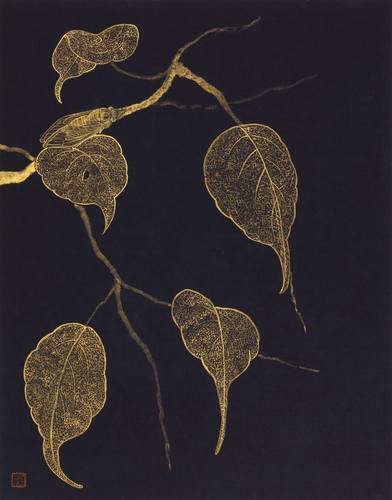
Prayer of A Cicada, HyunJung Kim
Drawing: goldpowder and realgold on Paper. Heaviness wrapped up with Lightness – Reading Kim HyunJung’s painting Lee DongChun (Fine art Connoisseur) Kim HyunJung’s paintings are cute and interesting. Her painting reminds us of paintings by Qi Baishi 齐白石 (1864-1957). Qi Baishi pursued beauty in his life, and his artistic spirit is found in his plant-and-insect paintings, flower-and-bird paintings, and figure paintings. Qi Baishi’s artistic spirit is sensed in Kim’s interesting subject matter and candid depiction.Kim audaciously uses ink and bright hues in in the manner of Qi Baishi who applied ink to leaves and red to flowers 墨叶红花. The composition in which subject matter is drawn to the edge of the paper is parallel to that of Qi Baishi’s flower-and-bird paintings and landscape painting of Li Keran’s 李可染 (1907-1989). Kim obviously learned from Qi Baishi. Qi Baishi said, “Learn from me you stand, copy from me you fall 学我者生, 似我者死.” Kim modeled herself after Qi’s artistic spirit rather than his painting style. Kim explored the artistic spirit in Qi Baishi’s painting, in which he emphasizes the meaning of painting and expresses his spirit, and reconstructed this in a realistic rendition. She calls this the “chulsa-ipgong 出写入工” technique. This is a melding of “xieyi 写意” painting (painting that underlines the painter’s spirit), “gongbi-hwa 工笔画” (painting done very carefully with the utmost care for details), and a new invention in tune with her emotion. Zheng Xie 郑燮 (1693-1765), one of the Eight Eccentrics of Yangzhou during the Qing Dynasty asserted, “Learn half, and throw away half 学一半, 撇一半.” This means even if a tradition is excellent, you have to learn only half of it. However, the traditional is currently completely disregarded. Kim learned her ‘half’ from traditional Eastern techniques. She studied the idioms of flower-and-bird painting from Song Dynasty, and learned from artists such as Chen HongShou 陈洪绶 (1599-1652), Yun ShouPing 恽寿平 (1633-1690), ShiTao 石涛 (1641-1707), BaDaShanRen 八大山人 (1625-1705), Gao QiPei 高其佩 (1660-1734), Jin Nong 金农 (1687-1764), and Kim HongDo 金弘道 (1745-1806). Moreover, she explored new methods in expression of color in traditional techniques. As she felt insufficiency in the use of pigment to depict significant parts of a painting, she made use of embroidery. This technique called “hwaju-subo 画主绣补” (Paining is used as primary and embroidery as ancillary) brought a new vitality to gongbi-hwa. The techniques of “chulsa-ipgong” and “hwaju-subo” are not the only revolution and innovation Kim has pursued. Getting psychological counselling, Kim realized the existence of her inner-child. She named her “Lala” and represented her special emotion in a pictorial language through this. Her Lala painting is a projection of her inner-child that she became aware of through psychological consultation, and for the artist a process of healing. This painting is in no way the product of pop art, but the sublimation of an artist’s inner-child to a work of art for the first time in art history. Kim’s Finding implicit rules is a portrayal of a young girl in meditation. The little girl carrying Lala on her back gazes vacantly at a dragonfly on a bare branch against the backdrop of a brick wall. Lala and the little girl look cute. The brick wall is a metaphor for constant time whereas the bare branches and dragonfly represent finite time in nature. The dragonfly acts out as the last leaf by O. Henry (William Sydney Porter, 1862-1910). As a projection of a psychological essay in painting, this work is a new literati painting of the 21st century reflecting Kim’s distinctive art-world. Kim lends new energy to gongbi-hwa through her realization of traditional Eastern painting. Kim has incarnated the spiritual world of intellectuals in our age in exquisite, flamboyant gongbi-hwa. This is why Chinese aestheticians and art historians have recently taken note of Kim’s painting.
https://www.saatchiart.com/art/Painting-Prayer-of-A-Cicada/960197/3943611/view
11 notes
·
View notes
Photo
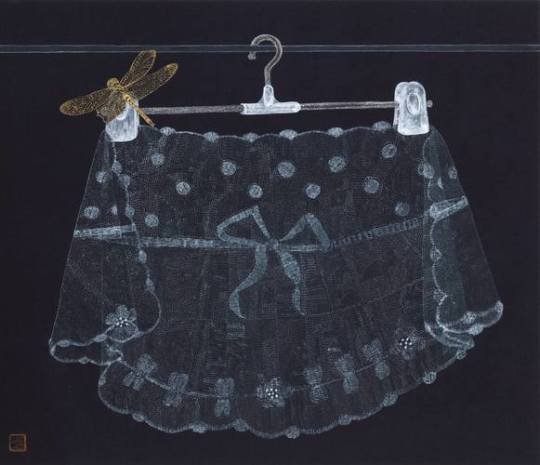
Veil, HyunJung Kim
Heaviness wrapped up with Lightness – Reading Kim HyunJung’s painting Lee DongChun (Fine art Connoisseur) Kim HyunJung’s paintings are cute and interesting. Her painting reminds us of paintings by Qi Baishi 齐白石 (1864-1957). Qi Baishi pursued beauty in his life, and his artistic spirit is found in his plant-and-insect paintings, flower-and-bird paintings, and figure paintings. Qi Baishi’s artistic spirit is sensed in Kim’s interesting subject matter and candid depiction.Kim audaciously uses ink and bright hues in in the manner of Qi Baishi who applied ink to leaves and red to flowers 墨叶红花. The composition in which subject matter is drawn to the edge of the paper is parallel to that of Qi Baishi’s flower-and-bird paintings and landscape painting of Li Keran’s 李可染 (1907-1989). Kim obviously learned from Qi Baishi. Qi Baishi said, “Learn from me you stand, copy from me you fall 学我者生, 似我者死.” Kim modeled herself after Qi’s artistic spirit rather than his painting style. Kim explored the artistic spirit in Qi Baishi’s painting, in which he emphasizes the meaning of painting and expresses his spirit, and reconstructed this in a realistic rendition. She calls this the “chulsa-ipgong 出写入工” technique. This is a melding of “xieyi 写意” painting (painting that underlines the painter’s spirit), “gongbi-hwa 工笔画” (painting done very carefully with the utmost care for details), and a new invention in tune with her emotion. Zheng Xie 郑燮 (1693-1765), one of the Eight Eccentrics of Yangzhou during the Qing Dynasty asserted, “Learn half, and throw away half 学一半, 撇一半.” This means even if a tradition is excellent, you have to learn only half of it. However, the traditional is currently completely disregarded. Kim learned her ‘half’ from traditional Eastern techniques. She studied the idioms of flower-and-bird painting from Song Dynasty, and learned from artists such as Chen HongShou 陈洪绶 (1599-1652), Yun ShouPing 恽寿平 (1633-1690), ShiTao 石涛 (1641-1707), BaDaShanRen 八大山人 (1625-1705), Gao QiPei 高其佩 (1660-1734), Jin Nong 金农 (1687-1764), and Kim HongDo 金弘道 (1745-1806). Moreover, she explored new methods in expression of color in traditional techniques. As she felt insufficiency in the use of pigment to depict significant parts of a painting, she made use of embroidery. This technique called “hwaju-subo 画主绣补” (Paining is used as primary and embroidery as ancillary) brought a new vitality to gongbi-hwa. The techniques of “chulsa-ipgong” and “hwaju-subo” are not the only revolution and innovation Kim has pursued. Getting psychological counselling, Kim realized the existence of her inner-child. She named her “Lala” and represented her special emotion in a pictorial language through this. Her Lala painting is a projection of her inner-child that she became aware of through psychological consultation, and for the artist a process of healing. This painting is in no way the product of pop art, but the sublimation of an artist’s inner-child to a work of art for the first time in art history. Kim’s Finding implicit rules is a portrayal of a young girl in meditation. The little girl carrying Lala on her back gazes vacantly at a dragonfly on a bare branch against the backdrop of a brick wall. Lala and the little girl look cute. The brick wall is a metaphor for constant time whereas the bare branches and dragonfly represent finite time in nature. The dragonfly acts out as the last leaf by O. Henry (William Sydney Porter, 1862-1910). As a projection of a psychological essay in painting, this work is a new literati painting of the 21st century reflecting Kim’s distinctive art-world. Kim lends new energy to gongbi-hwa through her realization of traditional Eastern painting. Kim has incarnated the spiritual world of intellectuals in our age in exquisite, flamboyant gongbi-hwa. This is why Chinese aestheticians and art historians have recently taken note of Kim’s painting.
https://www.saatchiart.com/art/Painting-Veil/960197/3943575/view
1 note
·
View note
Photo

A Poetic Gathering, Matsumura Goshun, late 1700s-early 1800s, Cleveland Museum of Art: Japanese Art
In Japan, both Chinese-style poems (kanshi) and Edo period Japanese poems (haikai) paralleled the Chinese literati and Japanese painting haiga traditions. Edo literati painter Matsumura Goshun painted eight poets from the anthology of 36 haikai poets compiled by his teacher Yosa Buson. When Buson died in 1783, Matsumura was asked to care for his teacher’s young daughter; Matsumura added paintings to Buson’s poetic writings to sell and raise money for her marriage. Here, he included Buson’s poem at the top of the painting. Size: Image: 106.4 x 26.8 cm (41 7/8 x 10 9/16 in.); Overall: 184.2 x 34 cm (72 1/2 x 13 3/8 in.) Medium: hanging scroll; ink and color on paper
https://clevelandart.org/art/1983.188
1 note
·
View note
Photo

Pryer of A Cicada / 貝葉蟬, HyunJung Kim
Heaviness wrapped up with Lightness – Reading Kim HyunJung’s painting Lee DongChun (Fine art Connoisseur) Kim HyunJung’s paintings are cute and interesting. Her painting reminds us of paintings by Qi Baishi 齐白石 (1864-1957). Qi Baishi pursued beauty in his life, and his artistic spirit is found in his plant-and-insect paintings, flower-and-bird paintings, and figure paintings. Qi Baishi’s artistic spirit is sensed in Kim’s interesting subject matter and candid depiction.Kim audaciously uses ink and bright hues in in the manner of Qi Baishi who applied ink to leaves and red to flowers 墨叶红花. The composition in which subject matter is drawn to the edge of the paper is parallel to that of Qi Baishi’s flower-and-bird paintings and landscape painting of Li Keran’s 李可染 (1907-1989). Kim obviously learned from Qi Baishi. Qi Baishi said, “Learn from me you stand, copy from me you fall 学我者生, 似我者死.” Kim modeled herself after Qi’s artistic spirit rather than his painting style. Kim explored the artistic spirit in Qi Baishi’s painting, in which he emphasizes the meaning of painting and expresses his spirit, and reconstructed this in a realistic rendition. She calls this the “chulsa-ipgong 出写入工” technique. This is a melding of “xieyi 写意” painting (painting that underlines the painter’s spirit), “gongbi-hwa 工笔画” (painting done very carefully with the utmost care for details), and a new invention in tune with her emotion. Zheng Xie 郑燮 (1693-1765), one of the Eight Eccentrics of Yangzhou during the Qing Dynasty asserted, “Learn half, and throw away half 学一半, 撇一半.” This means even if a tradition is excellent, you have to learn only half of it. However, the traditional is currently completely disregarded. Kim learned her ‘half’ from traditional Eastern techniques. She studied the idioms of flower-and-bird painting from Song Dynasty, and learned from artists such as Chen HongShou 陈洪绶 (1599-1652), Yun ShouPing 恽寿平 (1633-1690), ShiTao 石涛 (1641-1707), BaDaShanRen 八大山人 (1625-1705), Gao QiPei 高其佩 (1660-1734), Jin Nong 金农 (1687-1764), and Kim HongDo 金弘道 (1745-1806). Moreover, she explored new methods in expression of color in traditional techniques. As she felt insufficiency in the use of pigment to depict significant parts of a painting, she made use of embroidery. This technique called “hwaju-subo 画主绣补” (Paining is used as primary and embroidery as ancillary) brought a new vitality to gongbi-hwa. The techniques of “chulsa-ipgong” and “hwaju-subo” are not the only revolution and innovation Kim has pursued. Getting psychological counselling, Kim realized the existence of her inner-child. She named her “Lala” and represented her special emotion in a pictorial language through this. Her Lala painting is a projection of her inner-child that she became aware of through psychological consultation, and for the artist a process of healing. This painting is in no way the product of pop art, but the sublimation of an artist’s inner-child to a work of art for the first time in art history. Kim’s Finding implicit rules is a portrayal of a young girl in meditation. The little girl carrying Lala on her back gazes vacantly at a dragonfly on a bare branch against the backdrop of a brick wall. Lala and the little girl look cute. The brick wall is a metaphor for constant time whereas the bare branches and dragonfly represent finite time in nature. The dragonfly acts out as the last leaf by O. Henry (William Sydney Porter, 1862-1910). As a projection of a psychological essay in painting, this work is a new literati painting of the 21st century reflecting Kim’s distinctive art-world. Kim lends new energy to gongbi-hwa through her realization of traditional Eastern painting. Kim has incarnated the spiritual world of intellectuals in our age in exquisite, flamboyant gongbi-hwa. This is why Chinese aestheticians and art historians have recently taken note of Kim’s painting.
https://www.saatchiart.com/art/Drawing-Pryer-of-A-Cicada/960197/3514676/view
0 notes
Photo

Pryer of A Cicada / 貝葉蟬, HyunJung Kim
Heaviness wrapped up with Lightness – Reading Kim HyunJung’s painting Lee DongChun (Fine art Connoisseur) Kim HyunJung’s paintings are cute and interesting. Her painting reminds us of paintings by Qi Baishi 齐白石 (1864-1957). Qi Baishi pursued beauty in his life, and his artistic spirit is found in his plant-and-insect paintings, flower-and-bird paintings, and figure paintings. Qi Baishi’s artistic spirit is sensed in Kim’s interesting subject matter and candid depiction.Kim audaciously uses ink and bright hues in in the manner of Qi Baishi who applied ink to leaves and red to flowers 墨叶红花. The composition in which subject matter is drawn to the edge of the paper is parallel to that of Qi Baishi’s flower-and-bird paintings and landscape painting of Li Keran’s 李可染 (1907-1989). Kim obviously learned from Qi Baishi. Qi Baishi said, “Learn from me you stand, copy from me you fall 学我者生, 似我者死.” Kim modeled herself after Qi’s artistic spirit rather than his painting style. Kim explored the artistic spirit in Qi Baishi’s painting, in which he emphasizes the meaning of painting and expresses his spirit, and reconstructed this in a realistic rendition. She calls this the “chulsa-ipgong 出写入工” technique. This is a melding of “xieyi 写意” painting (painting that underlines the painter’s spirit), “gongbi-hwa 工笔画” (painting done very carefully with the utmost care for details), and a new invention in tune with her emotion. Zheng Xie 郑燮 (1693-1765), one of the Eight Eccentrics of Yangzhou during the Qing Dynasty asserted, “Learn half, and throw away half 学一半, 撇一半.” This means even if a tradition is excellent, you have to learn only half of it. However, the traditional is currently completely disregarded. Kim learned her ‘half’ from traditional Eastern techniques. She studied the idioms of flower-and-bird painting from Song Dynasty, and learned from artists such as Chen HongShou 陈洪绶 (1599-1652), Yun ShouPing 恽寿平 (1633-1690), ShiTao 石涛 (1641-1707), BaDaShanRen 八大山人 (1625-1705), Gao QiPei 高其佩 (1660-1734), Jin Nong 金农 (1687-1764), and Kim HongDo 金弘道 (1745-1806). Moreover, she explored new methods in expression of color in traditional techniques. As she felt insufficiency in the use of pigment to depict significant parts of a painting, she made use of embroidery. This technique called “hwaju-subo 画主绣补” (Paining is used as primary and embroidery as ancillary) brought a new vitality to gongbi-hwa. The techniques of “chulsa-ipgong” and “hwaju-subo” are not the only revolution and innovation Kim has pursued. Getting psychological counselling, Kim realized the existence of her inner-child. She named her “Lala” and represented her special emotion in a pictorial language through this. Her Lala painting is a projection of her inner-child that she became aware of through psychological consultation, and for the artist a process of healing. This painting is in no way the product of pop art, but the sublimation of an artist’s inner-child to a work of art for the first time in art history. Kim’s Finding implicit rules is a portrayal of a young girl in meditation. The little girl carrying Lala on her back gazes vacantly at a dragonfly on a bare branch against the backdrop of a brick wall. Lala and the little girl look cute. The brick wall is a metaphor for constant time whereas the bare branches and dragonfly represent finite time in nature. The dragonfly acts out as the last leaf by O. Henry (William Sydney Porter, 1862-1910). As a projection of a psychological essay in painting, this work is a new literati painting of the 21st century reflecting Kim’s distinctive art-world. Kim lends new energy to gongbi-hwa through her realization of traditional Eastern painting. Kim has incarnated the spiritual world of intellectuals in our age in exquisite, flamboyant gongbi-hwa. This is why Chinese aestheticians and art historians have recently taken note of Kim’s painting.
https://www.saatchiart.com/art/Drawing-Pryer-of-A-Cicada/960197/3514676/view
0 notes